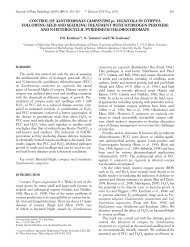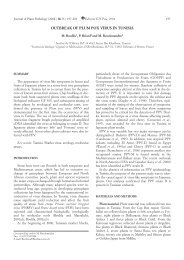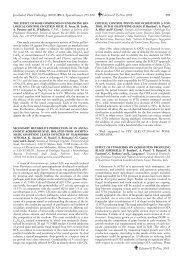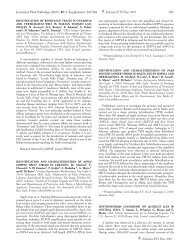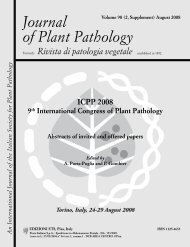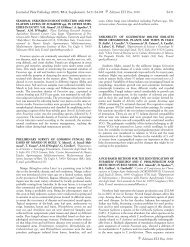Journal of Plant Pathology - Sipav.org
Journal of Plant Pathology - Sipav.org
Journal of Plant Pathology - Sipav.org
You also want an ePaper? Increase the reach of your titles
YUMPU automatically turns print PDFs into web optimized ePapers that Google loves.
<strong>Journal</strong> <strong>of</strong> <strong>Plant</strong> <strong>Pathology</strong> (2011), 93 (1, Supplement), S1.43-S1.51 S1.49<br />
ITSU5 and ITSR2) and β-tubulin (Bt1a and Bt1b, Bt2a and<br />
Bt2b) (Glass and Donaldson, 1995). These primers were able to<br />
discriminate genera and species. For grey mould, homology<br />
searches <strong>of</strong> amplicons confirmed the identification <strong>of</strong> B. cinerea;<br />
for Penicillium, most <strong>of</strong> the strains were P. expansum, whereas<br />
some strains were identified as P. minioluteum by ITS primer amplification.<br />
Suarez B.M., Walsh K., Boonham N., O’Neill T., Pearson S., Barker<br />
I., 2005. Development <strong>of</strong> real-time PCR (TaqMan) assays for the<br />
detection and quantification <strong>of</strong> Botrytis cinerea in planta. <strong>Plant</strong><br />
Physiology and Biochemistry 43: 890-899.<br />
Glass N.L., Donaldson G.C., 1995. Development <strong>of</strong> primer sets designed<br />
for use with the PCR to amplify conserved genes from filamentous<br />
ascomycetes. Applied and Environmental Microbiology<br />
61: 1323-1330.<br />
FAST SCREENING FOR PRESENCE OF MUDDY/<br />
EARTHY ODORANTS IN WINE AND IN WINE MUST US-<br />
ING A HYPHENATED GAS CHROMATOGRAPHY-DIF-<br />
FERENTIAL ION MOBILITY SPECTROMETRY (GC/<br />
DMS). M. Camara 1 , N. Gharbi 1 , E. Cocco 2 , C. Guignard 2 , M.<br />
Behr 2 , D. Evers 2 and P. Orlewski 1 . 1 Centre de Recherche Public-<br />
Gabriel Lippmann, Department <strong>of</strong> Research in Automotive Equipments.<br />
2 Centre de Recherche Public-Gabriel Lippmann, Department<br />
Environment and Agro-Biotechnologies, 41 Rue du Brill,<br />
4422 Belvaux, Luxembourg. E-mail: orlewski@lippmann.lu<br />
Rapid, hyphenated detection techniques involving a gas chromatograph<br />
(GC) coupled to a classical time-<strong>of</strong>-flight ion mobility<br />
spectrometer (IMS), or more recently, to a micro-machined,<br />
miniature differential ion mobility spectrometer (DMS) <strong>of</strong>fer a<br />
very interesting potential for the in-situ detection <strong>of</strong> many kinds<br />
<strong>of</strong> volatile <strong>org</strong>anic compounds (VOCS) (Eicemean, 2002) and notably<br />
those appearing in the headspaces <strong>of</strong> selected foodstuff.<br />
Early, time effective and mobile detection <strong>of</strong> <strong>of</strong>f-smelling earthy<br />
and muddy microbial volatile <strong>org</strong>anic compounds like geosmin<br />
and methyl-isoborneol (MIB) in grape must and in wine is <strong>of</strong> interest<br />
for winemakers, especially in more eastward and rainy wine<br />
regions. Indeed, the moist and rainy weather is among the main<br />
factors favouring infection <strong>of</strong> grapes by simultaneously occurring<br />
fungal pathogens such as Botrytis cinerea and Penicillium expansum,<br />
which frequently results in the emergence <strong>of</strong> <strong>of</strong>f-flavours in<br />
the must and wine. In the present work, we report the preliminary<br />
result <strong>of</strong> a study aiming at a fast, quantitative screening for<br />
geosmin in the headspace <strong>of</strong> wine and <strong>of</strong> grape must. We employed<br />
a field-deployable GC/DMS (Sionex, DMx) orthogonal<br />
detector, in parallel with a laboratory gold standard solid phase<br />
micro-extraction/gas chromatography/mass spectrometry<br />
(SPME-GC/MS) analysis has been taken as a reference. Prior to<br />
screening <strong>of</strong> wine headspaces, a series <strong>of</strong> GC-DMS spectra <strong>of</strong><br />
geosmin/MeOH solution at known concentrations allowed to setup<br />
optimal experimental conditions for geosmin detection. In<br />
spite <strong>of</strong> H 2<br />
O and EtOH saturated headspace in further examined<br />
wine samples, both positive and negative geosmin peaks were<br />
successfully identified in recorded spectra <strong>of</strong> two spiked white<br />
wines (Riesling and Elbling). We also detected the presence <strong>of</strong><br />
geosmin in a red wine sample that naturally (not spiked) contained<br />
a high amount <strong>of</strong> it. Concentrations estimated from observed<br />
product ion abundance were in line with SPME-GC/MS<br />
results yielded with parallel investigations. Preliminary results<br />
have shown the presence <strong>of</strong> geosmin in concentrations down to 5<br />
ng/l in white wines at the Df dispersion field <strong>of</strong> 23kV/cm, with a<br />
flash desorption <strong>of</strong> the trap column at 250°C and with a steady<br />
GC column temperature <strong>of</strong> 110°C. A very rapid sample setup<br />
time and short instrument duty cycle below 5 min, together with<br />
its high analytical sensitivity below the human olfactory (geosmin)<br />
threshold <strong>of</strong> 50 ng/l (Boutou and Chatonnet, 2007) are making the<br />
GC/DMS detection technique potentially suitable for in situ<br />
geosmin screening directly during the wine-making process.<br />
Eicemean G.A., 2002. Ion-mobility spectrometry as a fast monitor <strong>of</strong><br />
chemical composition. Trends in Analytical Chemistry 21: 259-<br />
275.<br />
Boutou S., Chatonnet P., 2007. Rapid headspace solide-phase microextraction/gas<br />
chromatographic/mass spectrometric assay for<br />
the quantitative determination <strong>of</strong> some <strong>of</strong> the main odorants causing<br />
<strong>of</strong>f-flavours in vine. <strong>Journal</strong> <strong>of</strong> Chromatography A 1141: 1-9.<br />
RESISTANT PROFILES OF PLASMOPARA VITICOLA<br />
POPULATION IN THE LUXEMBOURGIAN GRAPE-<br />
GROWING REGION. F. Giraud 1 , D. Molitor 2 , M. Bleunven 1 ,<br />
L. H<strong>of</strong>fmann 2 and D. Evers 2 . 1 Laboratoire BIORIZON<br />
(STAPHYT Groupe), Rue Magendie/Site Bordeaux Montesquieu,<br />
33650 Martillac, France. 2 Centre de Recherche Public-Gabriel<br />
Lippmann, Département Environnement et Agro-Biotechnologies<br />
(EVA), 41 Rue du Brill, 4422 Belvaux, Luxembourg. E-mail:<br />
fgiraud@staphyt.fr<br />
Downy mildew, caused by Plasmopara viticola (Berk. et M.A.<br />
Curtis) Berl. et De Toni, is an economically important disease <strong>of</strong><br />
the grapevine in many parts <strong>of</strong> the world. It affects both leaves<br />
and fruits, and is <strong>of</strong> particular importance in climates with abundant<br />
rainfall, high relative humidity, and long periods <strong>of</strong> wetness<br />
on leaves and fruits. In Luxembourg, downy mildew is one <strong>of</strong> the<br />
major constraints to grape production. Disease management <strong>of</strong><br />
downy mildew in most geographic areas generally requires the<br />
application <strong>of</strong> fungicides several times during the growing season,<br />
starting as soon as five leaves are unfolded (BBCH 15) in the cultivars<br />
typically grown in Luxembourg, i.e. Rivaner, Elbling, Riesling,<br />
Auxerrois, Pinot gris and Pinot blanc. One problem in the<br />
management <strong>of</strong> epidemics is the appearance <strong>of</strong> fungicide resistance<br />
in pathogen populations. Indeed, the introduction <strong>of</strong> selectively<br />
active site-specific fungicides into agricultural production<br />
systems has regularly been followed by the development <strong>of</strong> resistant<br />
fungal strains, decreasing the efficacy <strong>of</strong> chemical products.<br />
The situation becomes worrying in specific locations where more<br />
than one half <strong>of</strong> the natural population is resistant to one or more<br />
class <strong>of</strong> fungicides. Because <strong>of</strong> the cost <strong>of</strong> such frequent treatments,<br />
the desire to reduce pesticide levels in the environment<br />
and to preserve the fungicide utility and prolong their efficacy,<br />
considerable efforts have been made to counteract fungicide resistance.<br />
An essential part <strong>of</strong> such management strategies is the<br />
monitoring <strong>of</strong> fungal pathogen populations for their sensitivity to<br />
crop-protection compounds. These monitoring efforts should be<br />
based upon comparisons with baseline sensitivity data and the<br />
techniques must be suitably precise and reliable to detect relevant<br />
shifts in sensitivity within populations. In the BIORIZON laboratory<br />
the sensitivity <strong>of</strong> P. viticola has been monitored for over a<br />
decade, allowing comparison <strong>of</strong> sensitivities to some <strong>of</strong> the most<br />
commonly used fungicides (CAA, carboxylic acid amides; PA,<br />
phenyl-amides; QoI, quinone outside inhibitors). To study the<br />
current resistance status in the Luxembourgian grape-growing regions,<br />
leaf samples were collected from about 20 vineyards along<br />
the river Moselle in August 2010. Samples were analysed using<br />
biological tests (excised leaf disc assays and/or microplate assay<br />
with conidia growth inhibition). The main objective <strong>of</strong> this study<br />
was to measure the sensitivity <strong>of</strong> P. viticola populations to three<br />
classes <strong>of</strong> fungicide (CAA, PA, QoI) and to detect resistant populations<br />
in the Moselle area. To our knowledge, this preliminary<br />
study is the first report <strong>of</strong> the resistance/sensitivity pr<strong>of</strong>ile <strong>of</strong> the<br />
agent <strong>of</strong> downy mildew <strong>of</strong> grapevines in Luxembourg.



